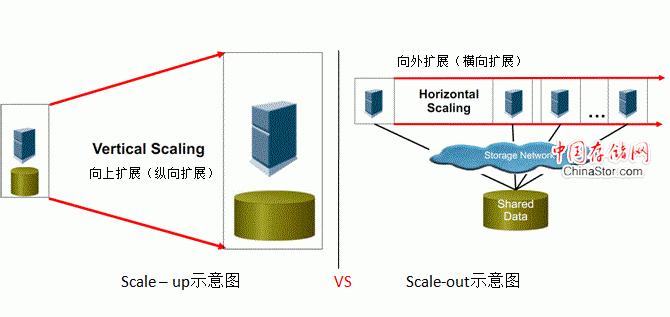导读:Scale Out(也就是Scale horizontally)横向扩展,向外扩展 Scale Up(也就是Scale vertically)纵向扩展,向上扩展 无论是Scale Out,Scale Up,Scale In,实际上就是一种架构的概念,这些概念用在存储上可以,用在数据库上,网络上一样可以。 简单比喻下Sc
You are here
Scale-up 和Scale-out的区别 有大用 有大大用
http://www.cnblogs.com/spork/archive/2009/12/29/1634766.html
来自原小站,曾经迷糊过的东西,表上来,希望对正在迷糊或即将迷糊的人有帮助。
谈到系统的可伸缩性,Scale-up(纵向扩展)和Scale-out(横向扩展)是两个常见的术语,对于初学者来说,很容易搞迷糊这两个概念,这里总结了一些把概念解释的比较清楚的内容。
首先来段Wikipedia的,讲的很透彻了。
Scale vertically (scale up)
To scale vertically (or scale up) means to add resources to a single node in a system, typically involving the addition of CPUs or memory to a single computer. Such vertical scaling of existing systems also enables them to leverage Virtualization technology more effectively, as it provides more resources for the hosted set of Operating system and Application modules to share.
Taking advantage of such resources can also be called “scaling up”, such as expanding the number of Apache daemon processes currently running.
Scale horizontally (scale out)
To scale horizontally (or scale out) means to add more nodes to a system, such as adding a new computer to a distributed software application. An example might be scaling out from one web server system to three.
As computer prices drop and performance continues to increase, low cost “commodity” systems can be used for high performance computing applications such as seismic analysis and biotechnology workloads that could in the past only be handled by supercomputers. Hundreds of small computers may be configured in a cluster to obtain aggregate computing power which often exceeds that of single traditional RISC processor based scientific computers. This model has further been fueled by the availability of high performance interconnects such as Myrinet and InfiniBand technologies. It has also led to demand for features such as remote maintenance and batch processing management previously not available for “commodity” systems.
The scale-out model has created an increased demand for shared data storage with very high I/O performance, especially where processing of large amounts of data is required, such as in seismic analysis. This has fueled the development of new storage technologies such as object storage devices.
------------------------------华丽的分割线---------------------------------------
英语不好?没关系,给你准备了一份中文的,来自这里,他用养鱼来做了个形象的比喻。
当你只有六七条鱼的时候, 一个小型鱼缸就够了;可是过一段时间新生了三十多条小鱼,这个小缸显然不够大了。
如果用Scale-up解决方案,那么你就需要去买一个大缸,把所有沙啊、水草啊、布景啊、加热棒、温度计都从小缸里拿出来,重新布置到大缸。这个工程可不简单哦,不是十分钟八分钟能搞得定的,尤其水草,纠在一起很难分开(不过这 跟迁移数据的工程复杂度比起来实在是毛毛雨啦,不值一提)。
那么现在换个思路,用Scale-out方案,就相当于是你在这个小缸旁边接了一个同样的小缸,两个缸联通。鱼可以自动分散到两个缸,你也就省掉了上面提到的那一系列挪沙、水草、布景等的折腾了。
来自 https://www.cnblogs.com/qiangxia/p/4208585.html
什么是Scale Up和Scale Out?

